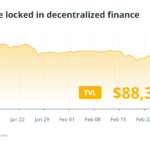In the dynamic world of cryptocurrency, Cardano’s ADA token is currently basking in an unexpected spotlight, thanks in part to a recent mention by former U.S. President Donald Trump. The buzz around ADA has led to a staggering increase in trading volumes, with daily figures averaging a remarkable 0 million in February and skyrocketing to over .4 billion in March. This surge underscores Cardano’s growing relevance within the broader crypto narrative, especially as President Trump identified it as one of the cryptocurrencies to be included in a proposed national strategic reserve.
Since its inception in late 2017, Cardano has been steadily carving out a niche as a formidable player in the blockchain space. With a market capitalization currently sitting at an impressive .6 billion, the project also boasts substantial user engagement—over 5 million unique wallets and 1.3 million active delegators are evidence of its robust ecosystem, as reported by Google. Moreover, thousands of new wallets are created each day, illustrating the increasing adoption of this layer-1 blockchain.
“I’m fighting to ensure that 50% of the activity is a non-value transaction,” asserted Frederik Gregaard, CEO of the Cardano Foundation, emphasizing the platform’s focus on real-world use cases.
Interestingly, Gregaard highlighted that the real impact of Cardano goes beyond mere financial transactions. He refers to “non-value transactions” such as minting decentralized identities and documenting metadata, which play a pivotal role in daily interactions on the Cardano blockchain. A noteworthy initiative in this direction is Cardano’s collaboration with Veritree, where the community’s contributions of over 1 million ADA tokens facilitated the planting of an equal number of mangrove trees in Kenya, all verifiable on the blockchain.
This proactive approach is further echoed in Cardano’s agreement with SERPRO, Brazil’s leading state-owned IT company, aimed at bolstering blockchain adoption across South America. SERPRO’s reach is substantial, processing a staggering 33 billion transactions annually for most of Brazil’s federal administration, and plans to provide blockchain training to 8,000 employees as part of this initiative.
While Cardano differentiates itself from competitors like Solana—focusing on hype-driven ventures and total value locked (TVL)—it still showcases a thriving DeFi landscape. Minswap, the native decentralized exchange for Cardano, recorded a cumulative trading volume of .4 billion this month, with promising figures in the lending sector reaching over 6 million in TVL. Nonetheless, Gregaard’s assertive strategy aims to maintain a balance, limiting financial transactions to ensure the foundation’s non-profit ethos prevails.
The governance structure of Cardano is a unique tapestry, involving three key entities: the Cardano Foundation, Charles Hoskinson’s Input Output Global (IOG), and Emurgo. While these entities often work collaboratively, there have been occasional tensions, as indicated by community discussions surrounding strategic decisions. Gregaard remains committed to fostering collaboration among these entities to sustain Cardano’s mission and maintain its integrity as a community-driven blockchain.

Cardano’s Recent Surge and Its Implications
The recent developments surrounding Cardano’s ADA token present significant insights for investors and followers of blockchain technology. Here are the key points to consider:
- Massive Increase in Trading Volume:
- Daily trading volumes have skyrocketed, averaging around 0 million in February and exceeding .4 billion in March.
- This rise was influenced by a social media post from U.S. President Donald Trump, highlighting ADA as part of the U.S. strategic crypto reserve.
- Growing Adoption Metrics:
- ADA’s market cap stands at .6 billion with over 5 million unique wallets and 1.3 million delegators.
- Cardano blockchain sees the creation of thousands of new wallets daily.
- Focus on Non-Financial Transactions:
- CEO Frederik Gregaard emphasizes real-world applications such as decentralized IDs and document tracking, rather than just financial transactions.
- The Cardano community has participated in initiatives like planting 1 million mangrove trees in Kenya, verifying donations on the blockchain.
- Strategic Partnerships:
- Collaboration with SERPRO, Brazil’s leading IT company, aims to enhance blockchain adoption in South America.
- Training for 8,000 employees will accelerate local blockchain integration.
- DeFi Ecosystem Development:
- Cardano’s native DEX, Minswap, recorded a cumulative trading volume of .4 billion this month.
- Numerous lending protocols exist that contribute to the burgeoning DeFi ecosystem within Cardano.
- Governance Dynamics:
- Cardano is managed by three entities: the Cardano Foundation, IOG, and Emurgo, which can create friction in decision-making.
- Frederik Gregaard notes the non-profit focus aims to ensure long-term benefits rather than short-term gains.
“We are the liability umbrella for the community and the blockchain, which means that we are the one who interacts with regulatory bodies.” – Frederik Gregaard
These aspects of Cardano’s development show how the blockchain is positioning itself as not just a financial tool but a platform for varied applications that can influence daily lives, from environmental initiatives to decentralized governance.
Cardano’s Rising Star: A Comparison with Competitors in the Blockchain Space
In the ever-evolving cryptocurrency market, Cardano’s ADA token stands out as a compelling case study. With a significant recent spike in trading volume, amplified by a notable endorsement from a U.S. political figure, it has drawn mainstream attention. But how does Cardano measure up against its peers, particularly in the realm of blockchain performance and strategic intent?
Competitive Advantages
Cardano is positioning itself uniquely in the ecosystem by emphasizing “non-value transactions.” This approach caters to real-world applications, such as decentralized identity and environmental projects like the collaboration with Veritree to plant mangrove trees in Kenya. This commitment to practical use cases sets Cardano apart from competitors like Solana and various layer-2 networks where the focus is heavily skewed towards DeFi metrics like total value locked (TVL) and hype-driven popularity. If success is measured by user engagement outside speculative trading, Cardano may be carving out a niche that fosters long-term sustainability.
Interestingly, its partnerships with significant entities, such as Brazil’s SERPRO, showcase Cardano’s intention to influence real-world economic frameworks. While Solana claims astronomical TVL figures fueled by fickle investments in meme assets and NFTs, Cardano’s infrastructure supports a range of pragmatic applications, pushing it into a different category of crypto utility.
Disadvantages and Challenges
Who Stands to Benefit or Face Challenges?

















